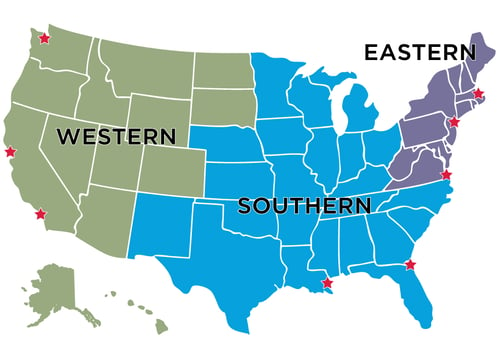The U.S. Department of Labor’s (DOL) Longshore Program (also known as DLHWC) enacted several sweeping changes during this most interesting year. From changes to their administrative structure to how claims forms are submitted, here’s a recap of four of these new developments.
Redistricting
Pursuant to Industry Notice No. 175, the DOL established three new compensation districts and re-designated the nine former compensation districts as suboffices:
- The Eastern Compensation District is comprised of the Boston, New York, and Norfolk suboffices
- The Western Compensation District is comprised of the Long Beach, San Francisco, and Seattle suboffices
- The Southern Compensation District is comprised of the Jacksonville, New Orleans, and Houston suboffices
The map below shows the states that comprise each compensation district.

Claims will be assigned on a rotating basis between the suboffice of the Eastern, Western, or Southern compensation districts based on the place of injury. For example, an injury that occurs in Florida will be assigned to either the Jacksonville, New Orleans or Houston suboffice based on the rotation.
Electronic Signatures
The DOL enacted a new policy to accept electronic signatures on documents submitted on longshore claims. Industry Notice No. 179 explains the types of acceptable electronic signatures and the recordkeeping required for those adopting this new policy. As most companies are paperless, and with an increasing number of communications generated through email, this was a welcomed change that has the potential to speed up claims resolution by eliminating delays when multiple parties are required to physically sign documents.
New Claim Forms
The DOL issued Industry Notice No. 180, which outlined new procedures and forms for stakeholders to use to request an action of the DLHWC. These forms include:
- Form LS-4 (Attorney Fee Approval Request)
- Form LS-5 (Application for Special Fund Relief)
- Form LS-6 (Commutation Application)
- Form LS-7 (Request for Intervention)
- Form LS-8 (Settlement Approval Request Section 8(i))
- Form LS-9 (Stipulation Approval Request)
The new forms function like a cover sheet and, upon receipt, alert the DOL to the filing which enables them to more efficiently take the appropriate action. For example, when a Form LS-8 (a settlement approval request) is uploaded by a party via the DLHWC’s online upload portal (SEAPortal), the responsible claims examiner will be notified of the request and an internal timetable will be initialized, ensuring that the application will be acted upon within the time required by the Longshore Act and code of federal regulations.
Longshore and Federal Employees’ Compensation Merger
In August, the DOL Office of Workers’ Compensation Programs (OWCP) announced the merger of the Division of Longshore and Harbor Workers’ Compensation (DLHWC) with the Division of Federal Employees' Compensation (DFEC) into the Division of Federal Employees’, Longshore and Harbor Workers’ Compensation (DFELHWC).
Tony Rios, former DFEC Director and Acting DLHWC Director, was named the first DFELHWC Director. A new position, Deputy Director of Longshore Claims, was also created, with responsibility overseeing the Longshore Program policy and operations. The Longshore Program leadership in the national office and District Directors will report to the yet-to-be-named Deputy Director of Longshore Claims. The new organizational chart can be viewed here.
According to Rios, “reorganization will allow the Longshore program to benefit from DFEC’s administrative resources and infrastructure, such as its information technology (IT) platforms, particularly as OWCP moves towards its vision of a single enterprise wide IT system serving all four programs.” He adds, “Administration of these claims will remain in separate entities within the same Division, but this reorganization will improve operations as a whole and allow both workforces to optimize the handling of all claims.”


